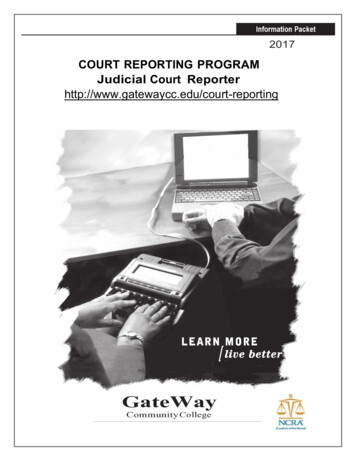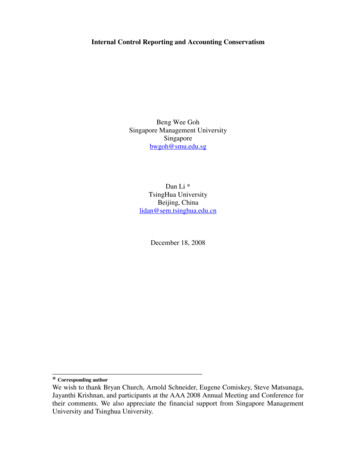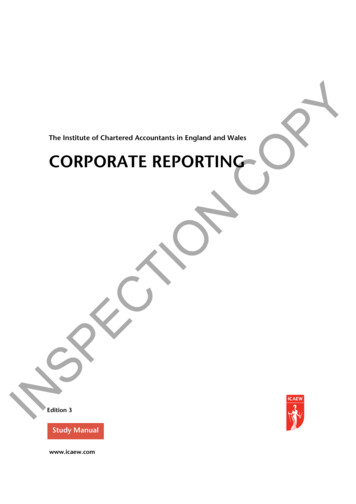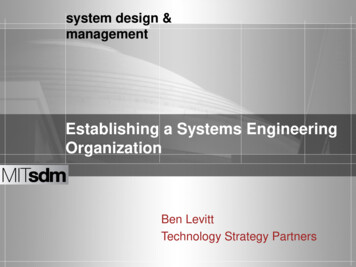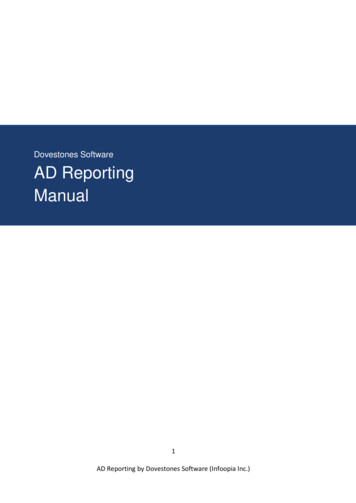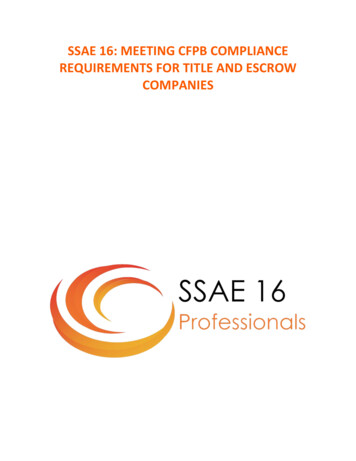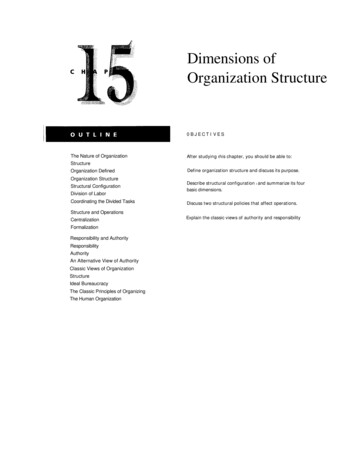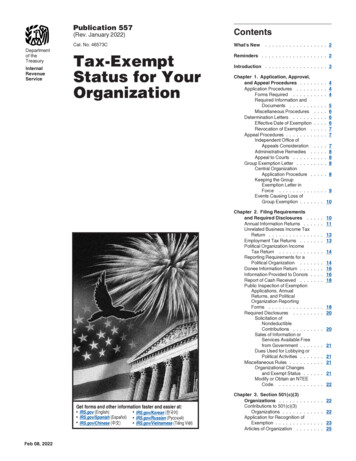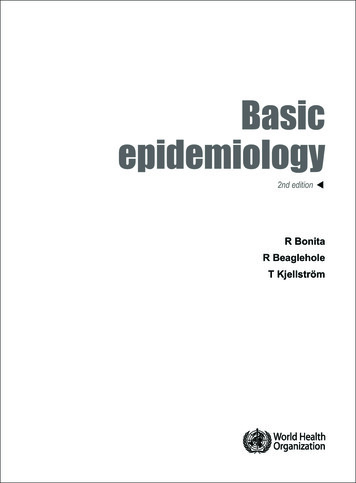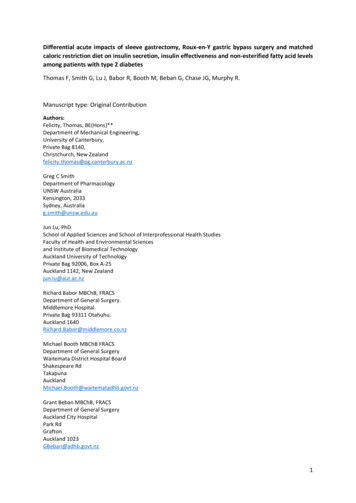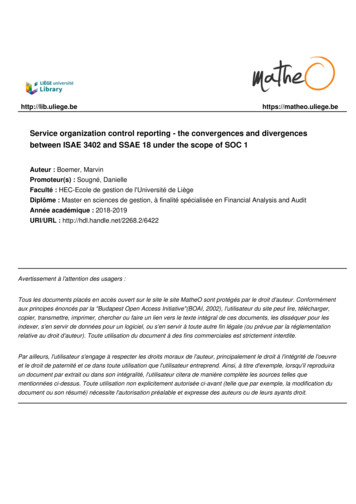
Transcription
e organization control reporting - the convergences and divergencesbetween ISAE 3402 and SSAE 18 under the scope of SOC 1Auteur : Boemer, MarvinPromoteur(s) : Sougné, DanielleFaculté : HEC-Ecole de gestion de l'Université de LiègeDiplôme : Master en sciences de gestion, à finalité spécialisée en Financial Analysis and AuditAnnée académique : 2018-2019URI/URL : http://hdl.handle.net/2268.2/6422Avertissement à l'attention des usagers :Tous les documents placés en accès ouvert sur le site le site MatheO sont protégés par le droit d'auteur. Conformémentaux principes énoncés par la "Budapest Open Access Initiative"(BOAI, 2002), l'utilisateur du site peut lire, télécharger,copier, transmettre, imprimer, chercher ou faire un lien vers le texte intégral de ces documents, les disséquer pour lesindexer, s'en servir de données pour un logiciel, ou s'en servir à toute autre fin légale (ou prévue par la réglementationrelative au droit d'auteur). Toute utilisation du document à des fins commerciales est strictement interdite.Par ailleurs, l'utilisateur s'engage à respecter les droits moraux de l'auteur, principalement le droit à l'intégrité de l'oeuvreet le droit de paternité et ce dans toute utilisation que l'utilisateur entreprend. Ainsi, à titre d'exemple, lorsqu'il reproduiraun document par extrait ou dans son intégralité, l'utilisateur citera de manière complète les sources telles quementionnées ci-dessus. Toute utilisation non explicitement autorisée ci-avant (telle que par exemple, la modification dudocument ou son résumé) nécessite l'autorisation préalable et expresse des auteurs ou de leurs ayants droit.
SERVICE ORGANIZATION CONTROLREPORTINGTHE CONVERGENCES AND DIVERGENCES BETWEENISAE 3402 AND SSAE 18 UNDER THE SCOPE OF SOC 1JuryPromoter:Danielle SOUGNÉReaders:Grace GARRAISKatty TOSIDissertation byMarvin BOEMERFor a Master Degree in ManagementSciences with a specialization inFinancial Analysis & AuditAcademic year 2018/2019
ACKNOWLEDGEMENTSI would like to express my deep gratitude to ProfessorDanielle Sougné, my research supervisor, for herexperienced guidance, her constructive suggestions andacademic approach of this work. I would also like to thankMs. Garrais and Ms. Tosi, my readers, for their usefulassistance and valuable resources throughout the writingof this work.Special thanks should be given to Mr. Anderson, Mr.Custine, Mr. Kuipers, Mr. Truyman, Ms. Serafin and Mr.Wagner for having agreed to answer the interviews,without which I would not have been able to complete thiswork. Their practical knowledge of the research subjectwas indeed of great help to me.I would also like to extend my thanks to Ms Piette and MsBlandiaux, my reviewers, for their proofreading and thesubtlety of their recommendations.Finally, I wish to thank my parents and close ones for theirinfallible support and their encouragements throughoutmy study at HEC Liège.
ABBREVIATED TABLE OF CONTENTSABBREVIATED TABLE OF CONTENTS . iLIST OF TABLES AND FIGURES . iiLIST OF ABBREVIATIONS . . . iiiPREFACE . . . vINTRODUCTION . 1LITERATURE REVIEW . . 4METHODILOGY & RESEARCH QUESTIONS . . . 5CHAPTER 1SERVICE ORGANIZATION . 7CHAPTER 2SERVICE ORGANIZATION CONTROL REPORTING . 23CHAPTER 3STANDARD-SETTING ORGANIZATIONS . 35CHAPTER 4ANALYSIS OF ISAE 3402 AND SSAE 18 45CHAPTER 5STUDY OF THE CONVERGENCES AND DIVERGENCES 53CHAPTER 6ETHICAL DIMENSIONS . 60GENERAL CONCLUSION 65LIST OF REFERENCES . . IAPPENDICES . . XIVTABLE OF CONTENTS . LIi
LIST OF TABLES AND FIGURESTABLESTable 1 - List of professionals interviewed. 5Table 2 - Identifying the 8 main advantages organizations have to outsource. 16Table 3 - SOC Reports Summary. 31Table 4 - The different AT-C sections of SSAE 18. 50Table 5 - BPO and KPO examples. XXIIITable 6 - Comparison table between BPO and KPO. XXIVTable 7 - Elements to test for each Trust Services Principle. XXVITable 8 - Summary table of the different SSO mentioned. XXXIVFIGURESFigure 1 - List of the Top10 countries ranked by outsourcing attractiveness. 12Figure 2 - Parties involved in a SOC reporting environment. 24Figure 3 - Without and with SOC reports. 33Figure 4 - Timeline of TPA standards.46Figure 5 - The different outsourcing types . XXIFigure 6 - Ranking of outsourcing attractiveness by country in 2017. XXIIFigure 7 - Trust Services Principles Application . . XXVFigure 8 - PIOB’s organization chart . . XXXIFigure 9 - Organizational structure of the IFAC. XXXIIIFigure 10 - Organizational structure of the AICPA. XXXIIIFigure 11 - Summary of the standards leading to the current SOC framework. XXXVIii
LIST OF ABBREVIATIONSAICPA - American Institute of Certified Public AccountantsASB - Auditing Standards BoardBCBS - Basel Committee on Banking SupervisionBPO - Business Process OutsourcingFASB - Financial Accounting Standards BoardIAASB - International Auditing and Assurance Standards BoardIAESB - International Accounting Education Standards BoardIAIS - International Association of Insurance SupervisorsIAPS - International Auditing Practice StatementsIASB - International Accounting Standards BoardIESBA - International Ethics Standards Board for AccountantsIFAC - International Federation of AccountantsIFAE - International Framework for Assurance EngagementsIFRS - International Financial Reporting StandardsIOSCO - International Organization of Securities CommissionsISA - International Standard on AuditingISAE - International Standards on Assurance EngagementsISQC - International Standards on Quality ControlISRE - International Standards on Review EngagementsISRS - International Standards on Related ServicesKPO - Knowledge Process OutsourcingLPO - Legal Process OutsourcingPcEEC - Pre-certification Education Executive CommitteePEEC - Professional Ethics Executive CommitteePIOB - Public Interest Oversight Boardiii
PSP - Payroll Service ProviderRPO - Recruitment Process OutsourcingSDO - Standards Developing OrganizationSEC - Securities and Exchange CommissionSOC - Service Organization ControlSSO - Standards Setting OrganizationTA - Transfer AgentTPA - Third-Party AssuranceTPCA - Third-Party Claim AdministratorTSP - Trust Services Principlesiv
PREFACEThis research thesis was carried out as part of the Master's degree in Management Sciences witha specialization in Financial Analysis and Audit, which is supervised by HEC Liège, BusinessSchool of the University of Liège.Although this work is intended to be as universal as possible, it is ineluctably oriented towardsa European and North American perspective. These markets are indeed the most affected bythe subject of this thesis. The theoretical framework as well as the concepts developed,however, remain applicable in the most extensive way.Terminology being crucial, the author would also like to highlight the fact that the term ‘ServiceOrganization Control’ abbreviated SOC, will be used through this work as a generical term.The author is indeed aware that the term SOC takes its origins from the American Institute ofCertified Public Accountants (AICPA) which introduced it with the auditing standard SSAE 16in 2010. At that time, a SOC audit was the terminology used by auditors performing an auditunder the SSAE 16 standard. The author considers, however, that this terminology is nowsufficiently recognized by audit professionals as a general term for any examination of serviceproviders internal control, regardless of the standard applied.v
INTRODUCTIONIn an increasingly globalized world, a major phenomenon has been interconnecting companiesfor decades now. Simultaneously a cause and a symptom of this globalization, outsourcing isindeed a major economical factor which has been evolving with the nature of capitalism itself.Trying to imagine a world without outsourcing is thus virtually impossible nowadays (Kim,2018).With a global market size of 85.6 billion USD in 2018, outsourced services undoubtedlyrepresent a massive business. Despite a modest decrease in regards to its 2014 peak (104,6billion USD), the size of the outsourcing market has approximately doubled since the beginningof the millennium (Statista, 2019).Over the last few decades, companies have indeed increasingly outsourced parts of theirsystems and business processes to service organizations. This transfer of activities from globalentities to specialized service providers has enabled companies to focus on their core business,cut their costs, and solve internal issues (Deloitte, 2016).In pursuit of efficiency and profitability, companies entering this kind of corporate relationshipare logically becoming more integrated with their service providers. This transfer of functionsand processes, however, has also resulted into a loss of control for companies. It has in factrelocated the internal control and monitoring of the outsourced processes to serviceorganizations while keeping the commercial risk on the companies relying on them (Deloitte,2018).It is within this context that organizations specialized into providing services to large firms,expressed their will to demonstrate the efficiency of their control processes. Obtaining anindependent assurance over their internal control has therefore become an important businessmatter for service organizations (Moss Adams LLP, 2017).The outsourcing phenomenon boom, the growth in business specialization and the increasingpressure on service organizations to demonstrate the quality of their internal control, haveincreased the demand for Third-Party Assurance (TPA) certifications over serviceorganization’s internal control. In practice, these independent certifications take the form ofdifferent kinds of reports which are all delivered within the framework of Service OrganizationControl, abbreviated SOC (Deloitte, 2018; PwC, 2019). While they are not mandatory forservice organizations, external auditors reviewing service users’ financial statements tend to1
rely more and more on those reports to decrease audit procedures (Moss Adams LLP, 2017).Due to all these factors, the SOC architecture is thus increasingly used as an audit frameworkfor assurance engagements on service organization’s internal control.The desire to write a research thesis on that topic arises from a personal observation: ServiceOrganization Control auditing and reporting, is an almost unknown or not enough understoodsubject among the academic and professional worlds. The general public probably has no ideawhat these terms actually mean. In the light of the impressive development of outsourcing andthe growing importance of third-party assurance, understanding and mastering suchindependent certification seems nonetheless to be increasingly critical. This is why ServiceOrganization Control Reporting will be the central point of this research thesis.As later established in this work, one type of SOC report is more prominent and betterrecognized than the others: the so-called SOC 1 Report. This internal control certification is infact regulated by two specific auditing norms: the international standard ISAE 3402, developedby the International Federation of Accountants (IFAC) and the American standard SSAE 18,created by the American Institute of Certified Public Accountants (AICPA). These twostandards will be the study subjects of the normative analysis performed in this work.In addition, although the American standard SSAE 18 was released in 2016, this norm has onlybeen in application since May 2017, which makes it a relatively topical subject to address.In regard of these different reasons, the purpose of this master thesis is therefore twofold:1. Serve as a guide for the general public and newcomers in the audit field willing to discoverthis increasingly important subject through a summary of all the necessary conceptssurrounding SOC.2. Provide a quality research work for academics and professionals eager to improve theirunderstanding on an audit topic not taught in school and little-known by managers andpractitioners.By using a series of research questions as guidelines to lead the research work, this thesis willalso fill a certain gap in the managerial literature. This research work indeed combines thetheoretical literacy found in the literature with the practical results of several interviewsconducted with business professionals. Those interviews were the most effective way to pushthe research beyond the theoretical findings and the limitations it entails. The Literature Reviewand Methodology sections hereafter will lay the foundations of the working approach speciallydefined for this thesis.2
The recent development and the demand for such independent certification has to be seen ascorrelating with the evolution of outsourcing and the boom of services organizations. This isthe reason why Chapter 1, besides defining Service Organization, significantly covers the topicof outsourcing. This chapter will explain the factors contributing to this phenomenon, theopportunities and risk of outsourcing, as well as the conceptual framework of the phenomenon.Chapter 1 will also describe different practical types of service organizations. The purpose ofthis chapter is to explain why today’s companies increasingly rely on service organizations.The second chapter describes the central point of this work: Service Organization ControlReporting. Chapter 2 will indeed lay the foundations of SOC reporting by explaining thereasons for such audits, defining the parties involved and describing what the subject of thesespecific audits exactly are. It will also detail the different ways to report it and analyze thebenefits of a standardized reporting format.The third chapter then defines what a Standard-Setting Organization is and examines thespecific entities developing and issuing the auditing standards organizing and regulating SOCaudits and reports. Chapter 3 will contextualize the current situations of these entities andprovide a guide to navigate through the profusion of standard acronyms.The fourth chapter is an analysis of the standards regulating SOC 1 examinations and reports.To achieve that investigation, Chapter 4 will first review the chronicle of third-party assurancestandards and then analyze the two standards currently applied: ISAE 3402 and SSAE 18.The fifth chapter is an in-depth study of the normative similarities and differences between thetwo standards previously mentioned. Chapter 5 will thus meticulously dissect those in order tobring to light their convergences and divergences.The sixth chapter is an academic requirement which aims to highlight the ethical dimensions ofthis thesis subject. Chapter 6 will so use one of the research questions as an introduction pointfor presenting the audit ethical principles as well as for proposing an open reflection over theindependency for SOC auditors.Finally, the general conclusion will summarize each chapter, recap the findings of all researchquestions raised as well as provide a closing point to this master thesis on Service OrganizationControl Reporting. In addition, the author will also set the limitations of the work and proposesome general recommendations for audit companies and service organizations.3
LITERATURE REVIEWThrough the next six chapters, this master thesis will refer to the managerial literature in aneffort to develop the different theorical concepts linked to Service Organization Control. Thisresearch work is based on numerous academic, professional, normative and legal sources. Thewide variety of references (books, scientific papers, conference papers, newspapers, reviewmagazines, standards, online documents and websites) and their diverse origins were also arequirement this work has constantly endeavored to respond to. The six chapters cite variousauthors and publications. Here is a sample of the main references mentioned.Chapter 1 - Service Organization, refers to the work of many academics and professionals tolay the conceptual foundations necessary for our research work. Numerous authors such asBuenaventura (2016), Gulzhanat (2012), Pande (2011), Sen and Shie (2006) or Troacă andBodislav (2012) to name but a few, have been cited for their theoretical studies on outsourcingconcepts. This work has been complemented by online sources and renowned onlinedictionaries such as the Cambridge Dictionary (2019).Chapter 2 - Service Organization Control Reporting, mainly refers to online documentpublished by reputed accounting and auditing organizations such as BDO (20018), Deloitte(2018), Moss Adams LLP (2017), PwC (2010) and different audit standards as well.Chapter 3 - Standard-Setting Organizations, has been completed with information provided bythe different standards bodies depicted in the chapter such as the IFAC (2019), the AICPA(2019) and their internal bodies and committees. As in Chapter 2, audit standards have beenused to carry out the work.Chapter 4 - Analysis of ISAE 3402 and SSAE 18, is based on the work of Van Beek and VanGils (2017), the personal study of the norms regulating SOC reports as well as on the results ofthe interviews (detailed hereafter) conducted as part of this thesis methodology.Chapter 5 - Study of the convergences and divergences, is the confluence point of this workproviding answers to most of the research questions raised. It refers to the two audit normspreviously analyzed in Chapter 4, the AICPA’s guide for SOC 1 (2017) as well as the preciousinterviews carried with audit and business professionals.Chapter 6 - Ethical dimensions, mainly refers to Code of Ethics for Professional Accountantspublished by the IESBA in 2018 and develops the ethical aspect of the subject.4
METHODOLOGY & RESEARCH QUESTIONSMethodologyThe purpose of this work is making the subject accessible for the general public and at the sametime helping academics and professionals to strengthen their understanding of this specifictopic. By providing answers to the research questions raised hereafter, the work will fill thepraxis gap of the literature. To achieve this objective, this research thesis is based on thefollowing methodology.The nature of the topic dictates the use of both the available managerial literature (as explainedin the previous page) and several interviews conducted with professionals in order to completethe study of the subject. This research thesis is therefore based on a qualitative approach since“no statistical procedures or other means of quantification” (Strauss and Corbin, 1990, pp. 17)are applicable. Conducting interviews is thus an effective way to obtain practical informationthat is not available in the literature. Two significant types of respondents have been identified:1. External Auditors. As explained in Chapter 2, they both draft and use SOC reports. Someauditors are specialized in that area and questioning them is an effective way to obtain sometechnical information and the practical knowledge missing in the literature.2. Service organizations Managers. They are the ones exploiting SOC reports. Serviceorganizations are at the heart of this work. Interviewing managers in charge of that matter isalso an adequate way to obtain information as well as an interesting different perspective thanthe one presented by the auditors.The table below presents a summary of all the professionals questioned.NameCompanyFunctionLocationDateTed AndersonEYAssurance Practice DirectorLuxembourg 16/04/19Bart KuipersPwCRisk Assurance DirectorBrussels03/05/19Bert TruymanDeloitteRisk Advisory DirectorBrussels20/05/19Jérôme WagnerIntegrale ISHead of Internal AuditLiège06/05/19Maryline SerafinEthiasHead of Internal AuditLiège10/05/19Julien CustineAedesQuality Control ManagerNamur24/05/19Table 1 - List of professionals interviewedAll interviews were based on a pre-determined questionnaire. The decision was made to createtwo different kinds of questionnaires in order to better target the person interviewed depending5
on whether he/she is an auditor or a service organization manager. The two types ofquestionnaire are disclosed in Appendices 1 and 2. Appendix 3 provides the profiles of theprofessionals interviewed. As detailed in this appendix, all interviewees allegedly have a longexperience and a good knowledge of SOC audits.It should also be noted that no respondent had received the above-mentioned document beforethe interview. The objective was to collect their raw opinion and answers in a face-to-face(whenever possible) discussion with the pre-established questions as guideline. But theinterviewer and the respondent were free to discuss some topics peripheral to the generalsubjects. All the exchanges were recorded in order to facilitate the discussion and to keep atrack of the interviews in the most effective way.Research QuestionsAs explained in Introduction, the general subject of this research thesis is the ‘ServiceOrganization Control Reporting’. But it also aims to study in particular the convergences anddivergences between the two standards regulating the SOC 1 reports: ISAE 3402 and SSAE 18.In order to achieve these objectives and set a guideline for this master thesis, several researchquestions have been formulated:Q1 - What is the main benefit of a standardized SOC reporting?Q2 - Do service organizations requesting a SOC report fully understand it?Q3 - How to explain the current normative situation regarding SOC reporting standards?Q4 - What are the main similarities between the two audit standards, ISAE 3402 and SSAE 18?Q5 - What are the main distinctions between the two audit standards, ISAE 3402 and SSAE 18?Q6 - What is the feasibility of drafting a joint SOC 1 report containing both ISAE 3402 andSSAE 18 requirements?These six research questions thus defined will be explained and answered through the differentchapters of this work. The second chapter, dealing with the different kind of SOC reports willreply to Q1 and Q2. The fourth chapter will be in charge of the assurance standards’ evolutionand Q3. Finally, Chapter 5 will provide a deep study of the convergences and divergences ofthe norms in order to answer to Q4, Q5 and Q6.6
CHAPTER 1SERVICE ORGANIZATION1.DefinitionsThe best academic approach to initiate this research thesis seems to be a definition process ofthe central point of this work: a ‘service organization’. Dictionaries do not propose, however,any specific definition of the term. The most valuable resources relating to norms vocabularyare standard-setting organizations such as the AICPA1 or the IFAC2 (meticulously describedand examined in Chapter 3). Those organizations are two major bodies establishing auditingstandards as well as defining their terminology (AICPA, 2019a; IFAC, 2019a). Both standardsetting boards define a service organization in their own particular way.1.1AICPA definitionAccording to the AICPA, a service organization is: “The entity (or segment of an entity) thatprovides services to a user organization that are part of the user organization's informationsystem” (ASB, 2016, SSAE 18, AT-C 320, par. 08, pp. 234). This first definition requires tounderstand the meaning of the term ‘entity’, which is defined as “an organization or a businessthat has its own separate legal and financial existence” by the Cambridge Dictionary3 (2019).This terminology used by the American Institute focuses on the legal and financial separationof the business bodies involved.1.2IFAC definitionThe second definition of a service organization is the one defined by the IFAC Board: “A thirdparty organization (or segment of a third-party organization) that provides services to userentities that are likely to be relevant to user entities’ internal control as it relates to financialreporting” (IAASB, 2009, ISAE 3402, par.9, pp. 7). Beside referring to entities, this definitionintroduces the concept of ‘third-party’ which is defined by the Cambridge Dictionary (2019)as: “a third person or organization less directly involved in an activity or in a legal case thanthe main people or organizations that are involved”. The key point of the InternationalFederation of Accountants definition is the low level of involvement of the third-party.1American Institute of Certified Public AccountantsInternational Federation of Accountants3All definitions from the Cambridge Dictionary (2019) in this work actually come from the online edition of thedictionary. This is the reason why no specific page number is indicated as reference for each definition.27
1.3Common point between these definitionsWhile being explained in different ways, the major connection between the AIPAC and theIFAC definitions of ‘service organization’ is the service provided by a third-party entity to auser organization and that service is relevant to the information system4/financial reporting5 ofthe principal company. The two definitions in fact use different terminologies to encompass thesame notion: ‘outsourcing’.1.4Outsourcing & SubcontractingAlthough never mentioned, both standard-setting organizations actually refer to the outsourcingconcept, defined by the Cambridge Dictionary (2019) as: “a situation in which a companyemploys another organization to do some of its work, rather than using its own employees todo it”.Another word often associated to outsourcing is ‘subcontracting’ which is determined as: “theact of paying an outside person or organization to do work that might normally be done withinan organization” (Cambridge Dictionary, 2019).At first sight these two concepts seem to be perfect equivalents. But subcontracting is in fact aspecific form of outsourcing. The main differentiation is related to the length of the relationshipbetween the two entities involved and also to the transmission of ownership or not (Guers,Martin, and Wybo, 2014). They refer to a report published in March 2005 by the French Social,Economic and Environmental Council6 (2005, pp.92):It could therefore be said that subcontracting, unlike outsourcing, partially concernsthe provision of a service in a given time and not necessarily over many years and –most importantly – does not imply that the activity was previously undertakeninternally. Outsourcing is further distinguished from subcontracting in that it tends tolead to long-term change (by subtraction from the original company to an economicthird party) in the boundaries of the company and the structural configuration of itsresources. It could be called a ‘contractualised’ and ‘monetised’ handover of afunction or activity previously included in the internal mode of governance.[translated by Guers et al., 2014, pp.3]4Refers to the AICAP definition.Refers to the IFAC definition.6CESE: Conseil Economique, Social et Environnemental de France, named ‘Conseil économique et social’ until23 July 2008 and referred in the bibliography as ‘Conseil économique et social’ because the aforementioned reportwas published in 2005.58
Another main differentiation point is the obligation of result for the service organization in thecase of outsourcing. The entity takes the integral responsibility of actions and results towardthe outsourcing company. As for a subcontracting deal, the contractor company is accountablefor the management and the outcome of the externalized activity (Barthélemy, 2007).It should be noted, however, that these distinctions between outsourcing and subcontracting, aswell as being ambiguous, have no substantive impact on the service organization concept. Thecondition for the third-party entities to be relevant to the information system/financial reportingof the principal companies is still respected in both cases. This is the reason why this researchthesis will not make any more distinction between outsourcing and subcontracting in thefollowing chapters. Both terms will be used in an interchangeable way.As a preliminary conclusion and at the light of these elements, our preparatory definitionprocess can so depict service organizations as the products of the outsourcing concept itself.2.Outsourcing as a phenomenonTroacă and Bodislav (2012) describe outsourcing as a relatively “old” economic phenomenonwhich started to take place after the Second World War but transformed into a global trend inthe 90’s. They refer to Aalders’ researches (2001) as well as Tim Hindle’s book Guide toManagement Ideas and Gurus (2008) published by The Economist. According to the tworesearchers from the Bucharest Academy of Economic Studies: “the concept of outsourcingcame from the American terminology ‘outside resourcing’, meaning to get resources from theoutside. The term was later used in the economic terminology to indicate the use of externalsources to develop the business, [ ]” (Troacă and Bodisla
ANALYSIS OF ISAE 3402 AND SSAE 18 . (AICPA) which introduced it with the auditing standard SSAE 16 in 2010. At that time, a SOC audit was the terminology used by auditors performing an audit under the SSAE 16 standard. The author considers, however, that this terminology is now
